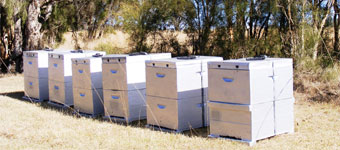Open Mon-Fri 8:00am to 4:30pm, Sat 8:00am to 11:30am, Closed all long weekends and Public Holidays

Open Mon-Fri 8:00am to 4:30pm, Sat 8:00am to 11:30am, Closed all long weekends and Public Holidays

Backyard Beekeeping 101: All You Need to Know (porch.com)
All beehives must be registered with the Department of Primary Industries in your State.
What you need to get started :
Please note that some items will need to be assembled as they are sold in kit form.
DPI Pack Registration forms etc QLD Free.
Bee boxes or "supers" as they are known come in 2 sizes. The smaller size can hold 8 frames and the larger can hold 10 frames. A double bee box is basically 2 of the single boxes stacked on top of each other. The double will hold twice as many frames according to the size chosen ie 2 x 8 frames or 2 x 10 frames. The double box also comes with a Queen excluder.
Once the hive is assembled and painted you are ready to introduce the bees known as a (nucleus) around $130.00 - $200.00 depending on the beekeeper.
When untreated pine is exposed to moisture, various organisms can attack/eat the wood , resulting in what we call 'Wood Rot'. Even in well painted pine, a nail or screw into the timber can provide access for moisture and these organisms. In less than 18 months, your newly assembled brood box, honey super or lid can be reduced to crumbling waste material.
If you want your hives to last for many years, and ensure a long productive life, the timber must be treated before you paint it.
Why uncap frames
In days of olde, honey comb was simply crushed to extract the liquid honey.
It takes bees a large effort to build the wax comb, and they consume considerable honey to create the wax. Once built, they can fill it with honey in a very short time, and it can be re-used for many years. For this reason, your comb is one of your most valuable resources.
The most efficient method to extract the honey, is to spin it out using centrifical force (see extractors). Each cell is sealed with a wax capping which must be removed before the honey can be extracted, hence the term - uncapping.
Over hundreds of years, people have kept bees in many types of hives, from hollow logs, to baskets and Skeps. The problem was they had to destroy the hive to extract the honey, plus they could not inspect the hive for disease.
Best protection - a strong hive
Fortunately honey bees do not succumb to many diseases. Keeping your hive strong, by ensuring good pollen/protein supplies, nectar, and a young queen, is the best protection against disease. The bees natural cleaning ability, combined with drawing foundation wax, helps limit the build-up of disease.
Summary Nosema disease is the most widespread adult bee disease in the world.
Although there are a number of symptoms, these often go unnoticed, and the poor performance of a colony is blamed on other factors.
There are no classic signs of the disease, and hence it frequently goes undetected.
Heavily infected bees live only half as long as non-infected bees.
Nosema disease is most likely present in all colonies all the time, and only likely to cause bee losses when conditions favour the micro-organism.
Why are there different flavours
Honey is produced all over the world and tastes different depending on which local flora the bees have been feeding on. Thus you might find lavender honey in France, or apple blossom from the UK, each with completely dissimilar flavour notes. Most Australian honey tends to come from native flowers, either blended or increasingly available as mono-floral honey.
The next time you suffer a minor cut or burn, you might want to reach for the honey jar instead of the antibacterial ointment. Honey has been used for thousands of years to protect wounds, so long that its medical use has fallen into folklore.
New Zealand research
A New Zealand biochemistry researcher aims to change that......Peter Molan, a biochemistry professor and director of the Honey Research Unit at the University of Waikato in New Zealand , has spent 18 years researching the medicinal properties of honey. "I was looking at other antibacterials and a friend who was a fanatical amateur beekeeper got me interested," Molan said.
The Australian New Zealand Food Standards Code defines honey, prescribes its composition and identifies the information that must be provided when labelling it for retail sale.
Definition
Standard 2.8.2 provides the following definition of honey:
The natural sweet substance produced by honey bees from the nectar of blossoms or from secretions of living parts of plants or excretions of plant sucking insects on the living parts of plants, which honey bees collect, transform and combine with specific substances of their own, store and leave in the honey comb to ripen and mature.
Aethina Tumida, or the Small Hive Beetle (SHB) is a member of the Sap beetle family and is a native of South Africa (first described by Andrew Murray in Nigeria in 1867) . There it is regarded as a nuisance, but not a dangerous pest possibly because of greater aggression shown by African bees towards the beetle.
It was first identified in Florida in 1998.
This pest is new to Australian beekeeping and was found in October 2002 around the Hawkesbury district of New South Wales and, as a result of migration of beehives, at Beerwah in Queensland.
Unit 4B / 10 Jijaws St.
Sumner Park, Qld 4074
Tel : 07 3376 5404
info@qbs.net.au
Mon - Fri : 8am - 4:30pm
Saturday : 8am - 11:30am
Closed all long weekends
Closed Public Holidays